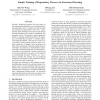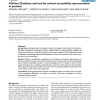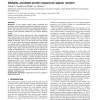188 search results - page 19 / 38 » Improving protein secondary structure prediction using a sim... |
BMCBI
2004
13 years 7 months ago
2004
Background: Hidden Markov Models (HMMs) have proven very useful in computational biology for such applications as sequence pattern matching, gene-finding, and structure prediction...
IJCAI
2007
13 years 9 months ago
2007
Recently, significant progress has been made on learning structured predictors via coordinated training algorithms such as conditional random fields and maximum margin Markov ne...
BMCBI
2004
13 years 7 months ago
2004
Background: Accessible surface area (ASA) or solvent accessibility of amino acids in a protein has important implications. Knowledge of surface residues helps in locating potentia...
BMCBI
2010
13 years 7 months ago
2010
Background: G-protein-coupled receptors (GPCRs) play a key role in diverse physiological processes and are the targets of almost two-thirds of the marketed drugs. The 3 D structur...
BIOINFORMATICS
2010
13 years 7 months ago
2010
Motivation: To test whether protein folding constraints and secondary structure sequence preferences significantly reduce the space of amino acid words in proteins, we compared th...



